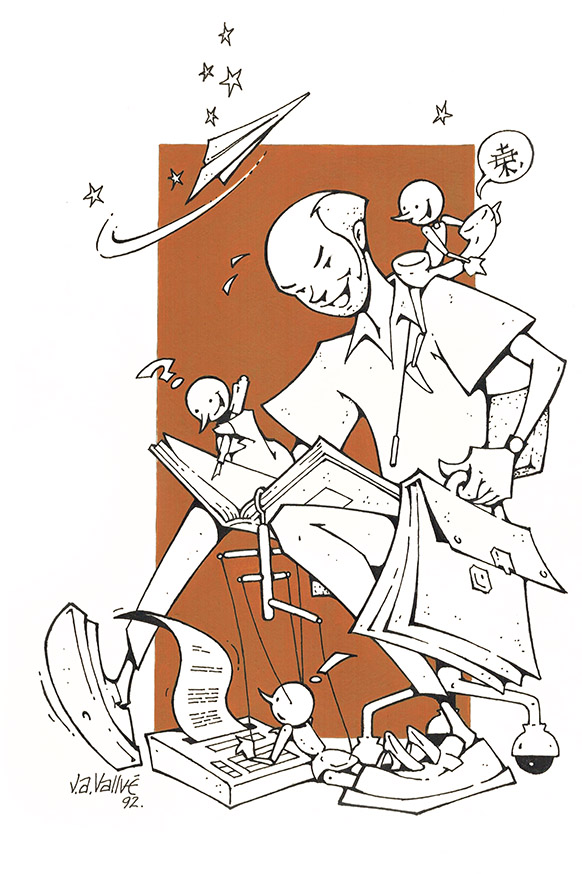Open Window Theatre

The archipelago of Polish performers working with matter – to cite Marzenna Wisniewska – is growing bigger. Apart from growing in number, the Object Theatre artists outside Poland reach out to countries where the tradition has not been very well-known so far. The Object Theatre artists have been actively directing outside Poland for a long time. To mention but a few, Jacek Zuzanski runs Dream Tale Puppets theatre in the US, Dominik Gasowski has founded Materia in Russia and, recently, and Wojciech Stachura creates Object Theatre projects in Holland. But Object Theatre’s diasporic circles keep growing. Among the latest gems a Norwegian Open Window Theatre created by Dominika Minkacz-Sira. Apart from Anna Skubik, Dominika Minkacz-Sira has been the first Polish female artist championing Object Theatre in Northern Europe. Almost a decade ago, Minkacz-Sira founded her own project – Open Window Theatre – and ever since she has been creating object theatre performances in Bergen, Norway’s second biggest city.
Although in the past years, apart from touring Norway, Germany and Lithuania, she has been repeatedly performing in Poland Open Window Thatre does not seem to be known to a large public. She usually performs in projects designed for children, sometimes the youngest ones. Until recently children have been the Theatre’s target audience. After finishing the Academy of Theatre and Puppetry in Wroclaw, it took her a while to find her way to transform her passion into a regular profession. When in 2006 she settled into her new home, a picturesque city of Bergen, she started running regular theatre groups for children and youths. Apart from that, she was teaching Norwegian. Finally, in 2015 she opened her own theatre. She called it the Open Window Theatre in a reference to a double meaning of a window, which simultaneously invites and presents challenge.
Until now, Open Window Theatre has released five plays. The first one was Nice girl based on a children’s book by Gro Dahle by the same name. For her second play, Minkacz-Sira also chose an adaptation of a Norwegian children’s book, Greger Grinebiter by Camilla Kuhn. Both plays were directed by Przemyslaw Jaszczak. Subsequently, together with Bergen National Theatre (Den Nationale Scene) she co-created (with the director, Alicja Morawska-Rubczak) two plays for children under 3. In 2020, she adapted a French children’s book on climate change 365 Penguins by Jean-Luc Fromental. Co-produced with Vestnorske Teatret, this Open Window Theatre project was directed by Radoslaw Kasiukiewicz. Although the performances do not have a permanent stage, they continue to reappear in theatre programmes all over the country and abroad. Although all the hitherto created Norwegian-language productions have been mainly a fruit of collaboration between Polish artists, Norwegians have also been contributing to the shows as actors, technicians, sound and light specialists, and producers. Apart from running Open Window Theatre, Dominika Minkacz-Sira acts in other plays and leads puppetry workshops. She occasionally works as a director’s assistant and animator. Open Window Theatre has been gaining popularity in Poland and in Norway, which is not that straightforward considering how little is known about object theatre in Norway. Even Plexus Polaire directed by a Norwegian Yngvild Aspeli, that made headlines abroad, has not been particularly talked about in the Norwegian theatre critique circles.

A few days ago Open Window Theatre has had a new premiere, Panoptikon. Freak show. Panoptikon is an object theatre play for adults that has the best chances of establishing Minkacz-Sira’s work as outstanding in the milieu of contemporary object theatre artists. The idea must have been born out of conversations between Minkacz-Sira and Jaszczak, the show’s director, about Scandinavian and Slavonic mythology, gradually enriched by other traditions, including the Greek and Mexican one. It explores mythical and legendary characters, put together in a ready theatre screenplay by Magda Fertacz. The play is divided into twelve scenes that marks the encounters between the Guide (an Entrepreneur) performed by Dominika Minkacz-Sira. She calls upon a variety of characters who parade onto the stage as a freak show. Next to a monster-woman (the Mutant) whose face is covered in hair, is a half-blind Drowned Woman, oblivious of her own history. Among male characters, there is Frankenstein (Victor Frankenstein’s son) made of corpses and brought to life with electro-shocks and the Troll, the Guide’s father, who, although entirely absent on stage, materialises as a video projection. A noteworthy character is that of a narcissistic Minotaur (a half-man, half-bull monster) in a golden mask.

The parade of characters performs in a show which at first sight seems to be pure entertainment run by the Guide showing the public freaks of nature and rare, peculiar human specimens. In her role as an Entertainer, Minkacz-Sira is peremptory, and imposing, even at times aggressive towards the characters; but as the show advances, she reveals herself as depressed and overwhelmed by the stories of each character she puts on display. Despite the awe and even disgust caused by the freak show, the spectators are confronted with the ambivalent character of each person that reveals the universality of fears, unfulfilled desires and failures, the lack of acceptance and even facing despise. The moral? The times when freak shows were meant as a marginal experience that reinforced the sense of normality are gone forever. Each of the characters turns out, apart from being excessive, also deeply transformative. The Guide ultimately discovers her own past and finds her father, the Troll. The Mutant turns out to be a dancer and performer Julia Pastrana affected by hypertrichosis, publicly mocked and her body desecrated before finally being repatriated to her native Mexico in 2013. Other characters, too, turn out to be more than just freaks on display, their stories – uncannily human.
Despite the importance of the verbal unfolding authored by Fertacz that stresses the narrative character of the inner journey in Panopticon the theatrical means of expression are absolutely central to the play. Even in the Norwegian version, the image, sound (composed by Urszula Chrzanowska), acting and animation constitute a perfectly intelligible narrative.
The set design, costumes and puppets were created by Aleksandra Starzynska, a Warsaw Academy of Fine Arts graduate who has been collaborating with theatres and object theatres for the last few years. The scenographer created a panopticon-shaped floor with a revolving stage platform in its centre on three columns that divide the stage into three separate spaces behind three curtains. Despite the revolving stage being in the centre, the show extends beyond it, like for instance in the scenes showing Frankenstein on a wheelchair or Pastrana on a glass display. On the right we can see the Guide’s vanity table. On both sides on the scenic space there are two large rocks that serve as depositories and screens for projections. On top of the stage there are also screens, where Mexican, Greek and aquatic themes are being projected. The whole set design, both suggestive and functional is truly impressive.

The most outstanding puppets are those of Pastrana and Frankenstein. The Mutant is a lovely slender form, dressed in a white dress with a high collar that serves as a drape that covers the animator. Her legs are the Minkacz-Sira’s legs, which makes her looks like a hybrid puppet at times. Pastrana’s costume hides the rods that help Minkacz-Sira animate the puppet. Their play is an excellent example of a contemporary convention, according to which the actress and a puppet are two independent characters. It is hard to stop staring at Pastrana and the hair glued to her face can only be spotted thanks to a bit of luck and the right angle.

Frankenstein appears as a naked latex corpse sitting in a wheelchair. He is being constructed as the performance unfolds. The particular body parts are attached one by one, first his legs, then his hands, and finally his head. And when the puppet is complete it turns out it is a sort of android whose body is remotely controlled by a computer and it moves independently from the animator’s will. It is an astonishing and impressive outcome. The eyeballs’, head’s and fingers’ movement have an electrifying effect. The authors have managed to demonstrate that Frankenstein is an actual living creature that can feel and dream. No wonder then that he strives to fulfil them.

If there is one thing that could be slightly improved it is the Drowned Woman puppet. She is attractive – a small head set on a long flexible spine ending in a kind of tulle fin. This form, however, tends to limit the scope for animation, and it is a pity that the creators did not find a way, especially in the second half of the show, after Drowned Woman reaches into the past of her predecessor Zosia, to diversify her shape and with it, its flexibility as an object in theatre.
The Troll character leaves the spectator likewise wanting. Although the Guide sprays the stage to remove his odour, he never materialises on the stage as a physical character. What a pity, one imagines what an impact his wrinkled face would have on the audience. Instead, he appears as a visual projection on the Guide’s back and, later on, on one of the two stones. Despite his physical absence, his visual representation enables emotions, so tightly linked to gazing in theatre. The dialogue scenes, where the Guide (Minkacz-Sira) and Troll-the father (Bjørn ‘Bamse’ Willberg Andersen of the National Theatre) are one of the most memorable. The actor’s soft and stirring voice leaves a lasting impression.

Dominika Minkacz-Sira is assisted by a number of partners in Panoptikon. She is accompanied on stage by Maja Bergebakken Sundt in the silent role of Brigitte, who at times performs a cleaner, and at others – the Guide’s assistant. The recorded voice of the Minotaur is provided by another Norwegian actor, Arild Brakstad. But Panoptikon is Dominika Minkacz-Sira’s show, her ability to liaise with other great artists being another proof of this impression.
Panoptikon is, it seems to me, a giant leap towards the holistic vision of object theatre for the entire creative team. This concerns most of all of Przemek Jaszczak, a director of the new generation who has been promoting object theatre for the last decade and is today an artistic director in the Maska Theatre in Rzeszow (south-east Poland). The object theatre is not a theatre founded on the written word. While various stories are often told there, in the object theatre a scenario is, aside images, sounds and, above all, actors-animators, just another aspect of the matter that serves to construct meaning.
Dominika Minkacz-Sira’s Open Window Theatre reaches out to new realities. In the era of declining Anthropocene we should pay attention to these new realities, as they reveal truths we have overlooked or simply ignored in the past.
Photos: HaWa
English translation: Ewelina Pępiak


